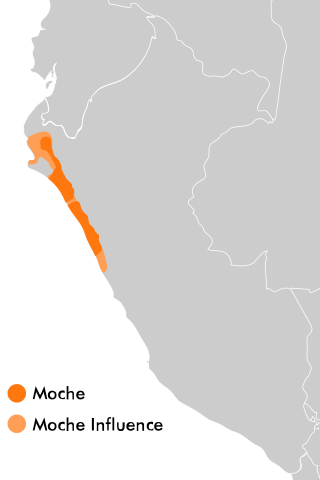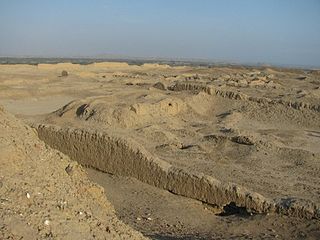Related Research Articles

A mummy is a dead human or an animal whose soft tissues and organs have been preserved by either intentional or accidental exposure to chemicals, extreme cold, very low humidity, or lack of air, so that the recovered body does not decay further if kept in cool and dry conditions. Some authorities restrict the use of the term to bodies deliberately embalmed with chemicals, but the use of the word to cover accidentally desiccated bodies goes back to at least the early 17th century.
Pachacámac is an archaeological site 40 kilometres (25 mi) southeast of Lima, Peru in the Valley of the Lurín River. The site was first settled around A.D. 200 and was named after the "Earth Maker" creator god Pacha Kamaq. The site flourished for about 1,300 years until the Spanish invaded. Pachacamac covers about 600 hectares of land.

The archaeology of the Americas is the study of the archaeology of the Western Hemisphere, including North America (Mesoamerica), Central America, South America and the Caribbean. This includes the study of pre-historic/Pre-Columbian and historic indigenous American peoples, as well as historical archaeology of more recent eras, including the Trans-Atlantic slave trade and European colonization.

The Moche civilization flourished in northern Peru with its capital near present-day Moche, Trujillo, Peru from about 100 to 700 AD during the Regional Development Epoch. While this issue is the subject of some debate, many scholars contend that the Moche were not politically organized as a monolithic empire or state. Rather, they were likely a group of autonomous polities that shared a common culture, as seen in the rich iconography and monumental architecture that survives today.

The Wari were a Middle Horizon civilization that flourished in the south-central Andes and coastal area of modern-day Peru, from about 500 to 1000 AD.

Momia Juanita, also known as the Lady of Ampato, is the well-preserved frozen body of a girl from the Inca Empire who was killed as a human sacrifice to the Inca gods sometime between 1440 and 1480, when she was approximately 12–15 years old. She was discovered on the dormant stratovolcano Mount Ampato in 1995 by anthropologist Johan Reinhard and his Peruvian climbing partner, Miguel Zárate. She is known as the Lady of Ampato because she was found on top of Mount Ampato. Her other nickname, the Ice Maiden, derives from the cold conditions and freezing temperatures that preserved her body on Mount Ampato.

The Paracas culture was an Andean society existing between approximately 800 BCE and 100 BCE, with an extensive knowledge of irrigation and water management and that made significant contributions in the textile arts. It was located in what today is the Ica Region of Peru. Most information about the lives of the Paracas people comes from excavations at the large seaside Paracas site on the Paracas Peninsula, first formally investigated in the 1920s by Peruvian archaeologist Julio Tello.

The practice of human sacrifice in pre-Colombian cultures, in particular Mesoamerican and South American cultures, is well documented both in the archaeological records and in written sources. The exact ideologies behind child sacrifice in different pre-Colombian cultures are unknown but it is often thought to have been performed to placate certain gods.

Johan Reinhard is an American anthropologist and archaeologist. He is Explorer-in-Residence at the National Geographic Society. He is also a senior research fellow at The Mountain Institute, a visiting professor at Catholic University, Salta, Argentina, an honorary professor of Catholic University, Arequipa, Peru, and a research professor at Future Generations University.

The Lord of Sipán is the name given to the first of several Moche mummies found at Huaca Rajada, Sipán, Peru by archaeologist Walter Alva. The site was discovered in 1987.

The Cajamarquilla archaeological site is located 25 km inland from the coastal city of Lima, Peru; in the Jicamarca Valley, 6 km north of the Rímac River. It occupies an area of approximately 167 ha, making it one of the largest archaeological monuments in the country. The site itself is now surrounded by several small villages which are encroaching upon, and threatening, its largely unfenced perimeter - despite its nationally 'protected' status.

The Sarcophagi of Carajía are unusually large pre-Inca Chachapoyas culture sarcophagi at the archaeological site of Carajía in the Utcubamba Valley, located 48 km northwest of the city of Chachapoyas, Peru in Luya Province, Amazonas Region. The site contains eight Chachapoyan mummies located on a cliffside, referred to by local residents as the “ancient wise men”.

Located in the Chicama Valley, the El Brujo Archaeological Complex, just north of Trujillo, La Libertad Province, Peru, is an ancient archaeological site that was occupied from preceramic times. Considering the broad cultural sequencing, the Chicama Valley can be considered as an archaeological microcosm. Research at the site benefits from the favourable environmental and topological conditions for material conservation.

Capacocha or Qhapaq hucha was an important sacrificial rite among the Inca that typically involved the sacrifice of children. Children of both sexes were selected from across the Inca empire for sacrifice in capacocha ceremonies, which were performed at important shrines distributed across the empire, known as huacas, or wak'akuna.

The Lima culture was an indigenous civilization which existed in modern-day Lima, Peru during the Early Intermediate Period, extending from roughly 100 to 650. This pre-Incan culture, which overlaps with surrounding Paracas, Moche, and Nasca civilizations, was located in the desert coastal strip of Peru in the Chillon, Rimac and Lurin River valleys. It can be difficult to differentiate the Lima culture from surrounding cultures due to both its physical proximity to other, and better documented cultures, in Coastal Peru, and because it is chronologically very close, if not over lapped, by these other cultures as well. These factors all help contribute to the obscurity of the Lima culture, of which much information is still left to be learned.

The Children of Llullaillaco, also known as the Mummies of Llullaillaco, are three Inca child mummies discovered on 16 March 1999 by Johan Reinhard and his archaeological team near the summit of Llullaillaco, a 6,739 m (22,110 ft) stratovolcano on the Argentina–Chile border. The children were sacrificed in an Inca religious ritual that took place around the year 1500. In this ritual, the three children were drugged with coca and alcohol then placed inside a small chamber 1.5 metres (5 ft) beneath the ground, where they were left to die. Archaeologists consider them as being among the best-preserved mummies in the world.

The Andean civilizations were South American complex societies of many indigenous people. They stretched down the spine of the Andes for 4,000 km (2,500 mi) from southern Colombia, to Ecuador and Peru, including the deserts of coastal Peru, to north Chile and northwest Argentina. Archaeologists believe that Andean civilizations first developed on the narrow coastal plain of the Pacific Ocean. The Caral or Norte Chico civilization of coastal Peru is the oldest known civilization in the Americas, dating back to 3500 BCE. Andean civilization is one of the six "pristine" civilizations of the world, created independently and without influence by other civilizations.

The Lady of Cao is a name given to a female Moche mummy discovered at the archeological site El Brujo, which is located about 45 km north of Trujillo in the La Libertad Region of Peru.

The Pacatnamu site is located at the mouth of the Jequetepeque Valley on the northern coast of Peru. Rocky cliffs protect two of its sides and a humanmade wall protects the third. This area of Peru does not have a tropical environment; it gets very little precipitation and has a mild climate, which sometime can become very humid.

The Tiwanaku Polity was a Pre-Columbian polity in western Bolivia based in the southern Lake Titicaca Basin. Tiwanaku was one of the most significant Andean civilizations. Its influence extended into present-day Peru and Chile and lasted from around 600 to 1000 AD. Its capital was the monumental city of Tiwanaku, located at the center of the polity's core area in the southern Lake Titicaca Basin. This area has clear evidence for large-scale agricultural production on raised fields that probably supported the urban population of the capital. Researchers debate whether these fields were administered by a bureaucratic state (top-down) or through a federation of communities with local autonomy. Tiwanaku was once thought to be an expansive military empire, based mostly on comparisons to the later Inca Empire. However, recent research suggests that labelling Tiwanaku as an empire or even a state may be misleading. Tiwanaku is missing a number of features traditionally used to define archaic states and empires: there is no defensive architecture at any Tiwanaku site or changes in weapon technology, there are no princely burials or other evidence of a ruling dynasty or a formal social hierarchy, no evidence of state-maintained roads or outposts, and no markets.
References
- 1 2 Inca Mummies (2012, March 12). Retrieved from
- 1 2 3 4 5 Inca Mummies: Secrets of a Lost World (2002). Production: Argo Films
- 1 2 3 4 5 Interview with Guillermo Cock (2002). Retrieved from
- ↑ Inca Mummies (2012, March 13). Retrieved from: http://library.thinkquest.org/28209/inca_mummy.htm Archived 2012-02-13 at the Wayback Machine
- 1 2 3 4 Thousands of Inca Mummies Raised from their Graves (2002). Retrieved from:
- 1 2 3 4 Argo Films (2012, March 12). Retrieved from: http://69.27.46.8/~argofilm/wordpress/films/inca-mummies-secrets-of-a-lost-world/ Archived 2012-11-28 at archive.today